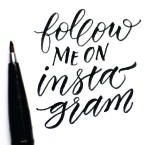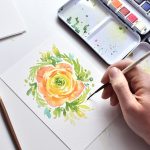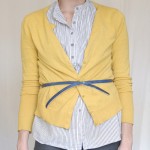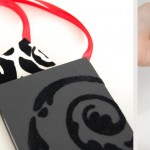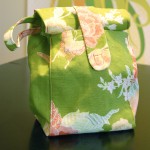
This post is sponsored by Leather Hide Store. Find a massive variety of high quality upholstery-weight leather at a great price.
Connect with Leather Hide store on Facebook, Twitter and YouTube. See their upholstery guide here.

I’ve had this seat for gosh nearly 3 years. It’s been patiently awaiting a loving touch in the corner of my studio. For the life of me I can’t find a before picture, but it’s not too terribly hard to imagine: dark oak legs and a 70s poo brown tweed cover over the seat cushions. It’s a simple silhouette. And for being so old and well-used (it was formerly a chair on BYU campus), it was in fabulous condition. A few scuffs and scrapes on the legs and a whole lot of dust.

Sitting on it was a dusty, scratchy experience. I felt like it could be easily elevated out of its sad state with a little bit of paint and leather. Unfortunately for everyone, it took a year to attack the upholstery once I started to take it apart.

It wasn’t that the upholstery work was terribly difficult. In fact, once I started the job, it wasn’t hard at all. The square shape of the upholstery made drafting up a pattern for the new cover super easy. And it didn’t take up a ton of material either. I don’t think I had more than 1/4th of a hide here and I had just enough to cover the entire thing.

The hardest part about the upholstery job was that Felix put a bolt inside one of the holes sideways (how he got it in there, I have no idea) so I spent a good hour working on getting it out.

I split a small part of the wood getting the legs on (see the above pic), but overall, it came together quite nicely. Putting the back panel of leather on was the most terrifying thing because I had to measure so precisely, account for the stretch of leather and use the most deadly upholstery tacks to nail into the frame so there are no raw edges. I’m sure those tacks were meant to go only through fabric, so it was a bit tough to get them to go through 2, sometimes 4, layers of 2 oz. leather.

Overall, I’m pleased with how it turned out. I think it looks nicely finished, and guests aren’t afraid to sit in the chair anymore! It also adds a lot of lightness to that corner of our living/family room. The old chair blended right in to the dark wood flooring.

Materials used:
Here’s a run-down of the process:
I took off the legs, measured the seat and drafted up flat paper patterns of the seat. I used a 5/8 seam allowance and made sure to write out the SA on every pattern piece.
After the patterns were done and checked against the existing chair, I cut out the leather. Since there were a lot of squares, each pattern piece was labeled and the leather was clipped to the pattern pieces until I sewed them so I could leave and come back to the project and know what pieces were sewed together and where.
From there, I got a bit freaked out about the sewing aspect of it all and switched to finishing the legs.
I used BB Frösch chalk paint for the legs, which was a huge time saver. No sanding or priming required. Just paint and go! The matte finish is pretty great, too. It makes me wish this had been around when we did our rocking chair eeons ago!
After I got the legs done, I (with the help of my intern last year) removed the prior upholstery. I wish we had done this outside because dust, old fabric fibers and countless number of staples just sprinkled my studio floor for weeks. Even now I still find a random staple. This chair had hundreds of hundreds of staples keeping the material on the frame! The dusty fabric made my studio smell horribly for days.
I sewed up the seams on the sides of each section (the top and bottom cushions are two separate pieces) and fit the leather on. I didn’t have to make any adjustments to the fit, thankfully, but I realized I needed to reinforce the ends of the seams so that they wouldn’t come undone. I grabbed my waxed linen thread for that and sewed up those ends for strength. Once I got the top and bottom cushions done, I affixed the legs, attached the back portion and then covered the bottom. I cleaned everything up and conditioned with leather conditioner and voila! It took me several months to complete it, but if I had worked continuously on the project, it wouldn’t have taken me longer than a Saturday morning and afternoon. I just got nervous about each step so I would take long breaks.

So there you have it! Read more for details on the living room!
(more…)











